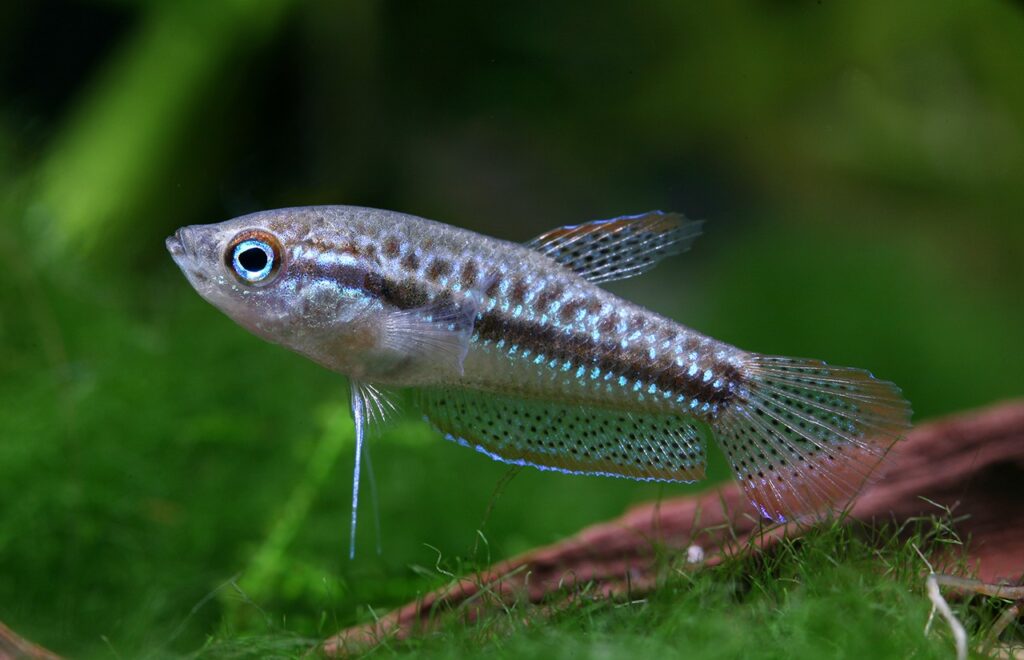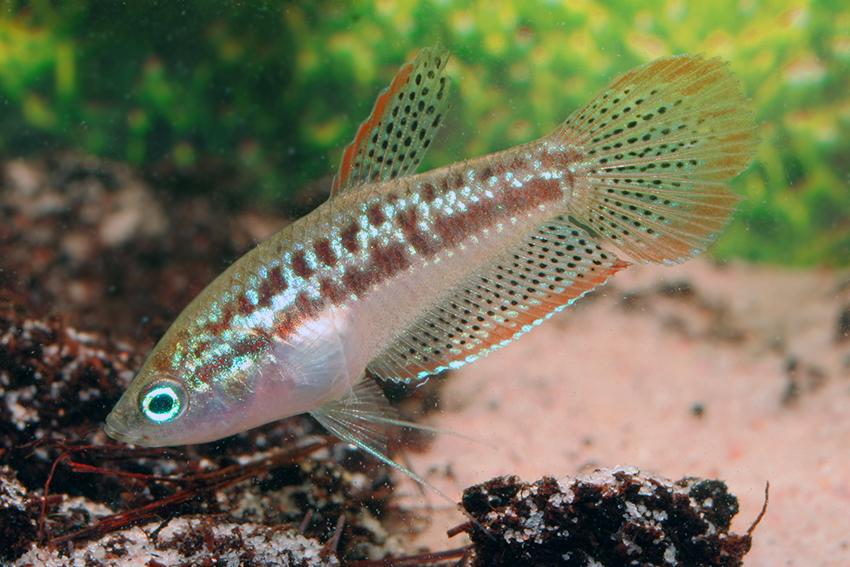Sparkling Gourami
Acquiring a Sparkling Gourami – Trichopsis pumila for your home aquarium is a delightful experience. Adorned with radiant scales and a range of unique physical traits, this serene and robust tropical fish is highly sought-after among both beginner and experienced fish keepers. Friendly towards different species yet can show hostility towards males of their own species.
- Experience Level: Beginner
- Hardiness: Hardy
- Minimum Tank Size: 20 gal (75 L)
- Maximum Size: 2 inches (5 cm)
- Temperament: Peaceful
- Temperature: 71 – 82° F (21.5 – 28° C)
- pH Range: 5.5 – 7.5
- Water Hardness: 5 – 12 dGH
- Diet: Omnivore
Table of Contents
Introduction
Size and Appearance
Care Guide
Tank Mates
Diet and Feeding
Breeding
The tranquil and slow rivers of Southeast Asia are the authentic habitat of the Sparkling Gourami.
This species can also be discovered in little ponds and paddy fields. Locals in Cambodia, Laos, Vietnam, and Thailand, refer to this species as the Pygmy Gourami or the Sparkling Dwarf Gourami due to their petite size and resemblance to the Dwarf Gourami. Nominally shy creatures, male Sparkling Gourami’s can exhibit aggressive behavior during mating season.
Internationally recognized as Trichopsis Pumila, the Sparkling Gourami stimulates interest in both fish keepers and ichthyologists. This interest arises from their labyrinth organ that functions similarly to diminutive lungs, allowing them to thrive in oxygen-deprived waters.
Size and Appearance
A variety of physical traits makes the Sparkling Gourami appealing to fish hobbyists of all levels of experience. This species exhibits an elongated body shape, tapering ends, and distinctly long fins – accounting for nearly a third of their body volume – which facilitate graceful movement.
With a maximum size of approximately 1.6 inches, this small and delicate fish is characterized by iridescent red and green scales. Each Sparkling Gourami possesses a unique configuration of patterns, shapes, and lines, ensuring individual members of a school can be identified from their physical markers.
As members of the Anabantoidei family, these fish are known to possess a labyrinth lung, enabling them to source oxygen from the surface of the water. Consequently, Sparkling Gouramis frequently ascend to the surface of your tank to replenish their oxygen supply.
Care Guide
- Minimum Tank Size: 20 gal (75 L)
- pH Range: 5.5 – 7.5
- Water Hardness: 5 – 12 dGH
- Temperature: 71 – 82° F (21.5 – 28° C)
- Lighting: Low, diffused lighting
- Substrate: Dark sand/gravel – Soft Substrate
- Brackish: No
- Water Flow: Weak/Low
- Tank Region: All areas, often rising to surface
To ensure a smooth adaption of Sparkling Gouramis to your aquarium, it’s essential to replicate their natural habitat conditions.
Perform several water cycles and inspect your tank’s parameters thrice before introducing your new Sparkling Gouramis. This process will ensure stable water parameters, limit toxin accumulation and prevent fluctuations in water quality.
The number of Sparkling Gouramis that can happily co-inhabit your tank will depend on its size. As a standard rule, a 15-gallon aquarium should house a single Sparkling Gourami, with each additional member requiring a further 10-15 gallons.
While it is plausible to house a solitary Sparkling Gourami, they thrive when kept in groups of at least four. Overcrowding should be avoided, as it may negatively impact their health and the overall eco-balance of the tank.
To replicate their natural, calm environment, it’s recommended to use gentle filtration methods like sponge filters or external filters. Some owners choose to forgo filters altogether when maintaining a dedicated Sparkling Gourami tank.
Avoid exposure to harsh lights and consider investing in LED lights with integrated timers and intensity controllers. This measure will coax your fish from their hiding spots, and also helps to limit excessive algae growth.
Incorporating live aquatic plants and décor offers a safe, natural and familiar environment for Sparkling Gouramis. Recommended live plants include Anubias, Hornwort, Wisteria, and Java Fern. Small rock formations, driftwood, and natural debris can supplement spatial interest and hiding spots. These fish prefer dark, gravel substrate.
Even though Sparkling Gouramis can survive in low oxygen environments and consume algae, they cannot endure high levels of toxins within the tank. Therefore, regular minor water changes are necessary for maintaining optimal tank conditions and promoting a healthy living environment for your fish.
Tank Mates
As cordial and non-territorial species, Sparkling Gouramis make an excellent addition to community tanks.
- Gourami Species: Coupling them with other Gourami species can ensure a vibrant and active aquarium. Maintain a 2:1 ratio of females to males for cohabitation harmony.
- Catfishes and Loaches: Bottom-dwelling species like Corydoras Catfish and Clown Loach make for ideal companions to your Sparkling Gouramis.
- Tetras and Rasboras: Small peaceful freshwater species like Neon Tetra and Harlequin Rasbora also make good neighbors for Sparkling Gouramis.
Ensure that chosen tank mates are not significantly larger or threatening in nature. Be cautious with introducing shrimp to the tank as Sparkling Gouramis can harass and attempt to eat them.
Feeding Guide
- Diet: Omnivore
- Frequency: Several small feedings per day
- Pellet Foods: Yes, sinking pellets are best
- Flake Foods: Yes, presoaked helps to sink, although comfortable fish will take them from the surface
- Live Foods: Yes
- Meat Foods: Yes
- Vegetable Foods: Yes, will often take partly cooked, dark leafy greens
Sparkling Gouramis display no fussiness over their diet and will happily accept most food types on a daily basis. When acclimating to a new tank or adjusting to larger tank mates, you may observe some hesitance in feeding habits. Until the Sparkling Gouramis are fully comfortable, consider feeding them sinking flakes or pellets.
As your Sparkling Gouramis grow more comfortable, diversify their menu with the inclusion of live baby shrimp, insects, and protein-rich food. Freeze-dried daphnia, tubifex, and bloodworms can add an exciting variety to their diet. However, avoid overfeeding as it may lead to health issues and accumulation of waste in the tank.
Breeding
Sparkling Gouramis are straightforward to breed. Follow the steps below to learn how to breed these species:
Start with a group of 4-6 Sparkling Gouramis. Distinguish females by their rounder fins, while males exhibit pointed ones.
Transfer the breeding pairs to a dense aquatic plant environment, simulating a breeding-friendly environment whilst reducing stress levels due to other tank company.
Emulate optimal breeding conditions by increasing the water temperature to approximately 76 Fahrenheit. Ensure a protein-rich diet is provided.
Following a few days in the breeding tank, the male Sparkling Gourami starts to construct a bubble nest in the plants. The impressed female will then lay eggs, which the male fertilizes and shields in the bubble nest.
After fertilization, it’s suggested to move the female Sparkling Gourami away and provide plankton and freshly hatched Artemia for the fry.



